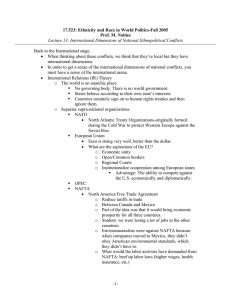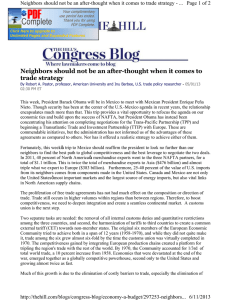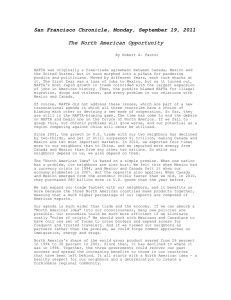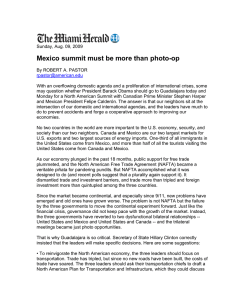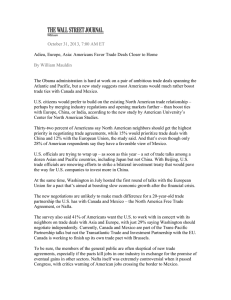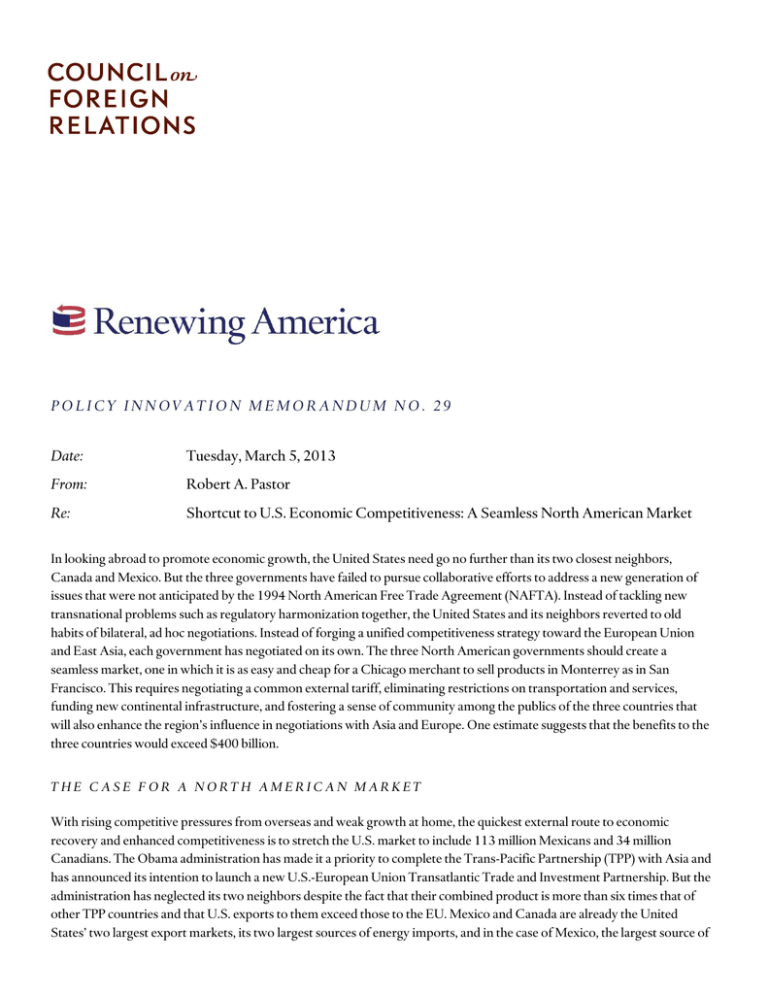
POLICY INNOVATION MEMORANDUM NO. 29
Date:
Tuesday, March 5, 2013
From:
Robert A. Pastor
Re:
Shortcut to U.S. Economic Competitiveness: A Seamless North American Market
In looking abroad to promote economic growth, the United States need go no further than its two closest neighbors,
Canada and Mexico. But the three governments have failed to pursue collaborative efforts to address a new generation of
issues that were not anticipated by the 1994 North American Free Trade Agreement (NAFTA). Instead of tackling new
transnational problems such as regulatory harmonization together, the United States and its neighbors reverted to old
habits of bilateral, ad hoc negotiations. Instead of forging a unified competitiveness strategy toward the European Union
and East Asia, each government has negotiated on its own. The three North American governments should create a
seamless market, one in which it is as easy and cheap for a Chicago merchant to sell products in Monterrey as in San
Francisco. This requires negotiating a common external tariff, eliminating restrictions on transportation and services,
funding new continental infrastructure, and fostering a sense of community among the publics of the three countries that
will also enhance the region’s influence in negotiations with Asia and Europe. One estimate suggests that the benefits to the
three countries would exceed $400 billion.
THE CASE FOR A NORTH AMERICAN MARKET
With rising competitive pressures from overseas and weak growth at home, the quickest external route to economic
recovery and enhanced competitiveness is to stretch the U.S. market to include 113 million Mexicans and 34 million
Canadians. The Obama administration has made it a priority to complete the Trans-Pacific Partnership (TPP) with Asia and
has announced its intention to launch a new U.S.-European Union Transatlantic Trade and Investment Partnership. But the
administration has neglected its two neighbors despite the fact that their combined product is more than six times that of
other TPP countries and that U.S. exports to them exceed those to the EU. Mexico and Canada are already the United
States’ two largest export markets, its two largest sources of energy imports, and in the case of Mexico, the largest source of
2
immigrants. The three countries also make products together. Unlike U.S. trade with most other countries, roughly 25 to
40 percent of the value of U.S. imports from Canada and Mexico comes from components made in the United States, and
then assembled into finished goods in one of the two countries. Closer integration would translate into a more efficient
supply chain and improved competitiveness. With labor costs in China rising to those in Mexico, and the cost of
transportation across the Pacific increasing, a North American supply chain is not only more efficient than an Asian route,
but it could also become a strong export platform to Asia. Moreover, if the United States seeks a unified approach to trade
negotiations with Mexico and Canada, Asia and Europe will recognize that Washington has other options, and prospects
for concluding transpacific and transatlantic trade deals would likely improve. For example, in the 1990s, world trade talks
were stalemated until NAFTA was signed.
WHERE NAFTA WENT ASTRAY
North America was on track to create a competitive market in the 1990s. The most rapid job expansion in recent U.S.
history occurred between 1993 and 2001. This coincided with the onset of NAFTA and the end of most trade and
investment barriers between the United States, Canada, and Mexico. Trade tripled and foreign direct investment grew
fivefold. But 2001 proved to be a turning point for North America just as the outlines of a continental market were
becoming visible. Growth in trade has since declined by two-thirds and foreign investment by half.
There are multiple causes for the decline. China entered the World Trade Organization (WTO) and rapidly expanded its
exports to all three countries in North America. Post-9/11 restrictions significantly raised the cost of moving products back
and forth across North American borders. There has been little investment in common infrastructure, resulting in long wait
times at borders and slower movement of commercial goods. But the main cause was simply the failure of leaders in the
three countries to build on NAFTA’s foundation and create a seamless market.
Deepening North American integration is more productive than widening it to add more free trade agreements (FTAs), but
it will require the United States to address numerous domestic issues with its neighbors. Regulatory requirements should
be meshed so as to eliminate trade protection while also ensuring safety and environmental concerns. National
infrastructure grids—roads, railroads, electricity, and natural gas pipelines—should be built and connected. Repetitive and
unnecessary border inspections should be eliminated. Labor market needs should be addressed on a continental basis.
TOWARD A SEAMLESS NORTH AMERICAN MARKET
To invigorate the three economies and forge a higher level of competitiveness, the North American governments should
undertake the following measures:
Build public support for a shared vision. North American leaders should say clearly that economic progress depends on closer
collaboration. The three leaders should speak often of the common North American vision and community and bring it to
life with symbolic steps—such as a “Buy North American” ad campaign, instead of “Buy American.” There should be more
educational exchanges and support for North American research centers.
Negotiate a common external tariff. This would permit products to cross North American borders without any customs
forms, inspection, or duty. Current “rules of origin” requirements mandate that goods must contain a certain level of North
American content to qualify for NAFTA tariff preferences, which slows commerce and costs consumers billions of dollars.
Review and eliminate all restrictions in transportation and services. The U.S. government violated NAFTA for more than fifteen
years by prohibiting Mexican trucks from entering the United States. Although the U.S. government finally relented last
year after WTO rulings, Mexican shippers are reluctant to upgrade their equipment without assurance that these barriers
3
are gone for good. Other barriers include cabotage, which prevents trucks from depositing and acquiring cargo at different
points on long journeys, and the Jones Act, which subsidizes American maritime transportation. In addition, while the
exchange of services (e.g., banking, engineering, consulting, and health care) is increasingly important, professional
certification and parochial regulations retard their growth. All these restrictions should be eliminated.
Forge a continental plan for transportation and infrastructure. Led by each country’s minister of transportation, the countries
should build new trade corridors, improve railroads and ports, and construct a new highway that stretches from Canada to
southern Mexico. Funding for the infrastructure could come from the common tariff, which should yield about $45 billion
annually. These funds would be managed by a North American Investment Fund, which could be administered by the World
Bank with decision-making in the hands of the three governments.
Create a single North American working group on regulatory issues with a comprehensive strategy. Currently there are two
separate bilateral working groups—U.S.-Canada and U.S.-Mexico—that negotiate individual regulations, but they have
failed to agree on a single one. A merged working group should aim for across-the-board regulatory convergence. This
means that pharmaceuticals should be subject to uniform high standards and would not need to be retested in each country,
that food imports should be tested just once by North American inspectors, and that regulations on the size, weight, and fuel
efficiency of trucks should be the same in all three countries.
Adapt immigration policies to a wider labor market. The United States and Canada should permit their citizens to work freely
in either country. This step is not possible with Mexico until the income gap narrows, but other steps should be taken.
NAFTA visas for professionals should be easier to obtain and extend longer for Mexicans. An expanded guest-worker
program for Mexicans should be included in comprehensive immigration reform, and to prevent abuse, biometric
identification should be required for hiring all employees.
For the United States and Canada, negotiate a new energy framework. The framework should balance the region’s need for
energy security with the necessity of curbing carbon emissions. The two countries should also develop ways to reduce the
multiple-approval process for hydroelectricity transfers and negotiate a plan for future oil and natural gas pipelines. Mexico
should be invited to participate but will probably wait until it completes domestic energy reforms.
Make antitrust policies continental. In a continental market, national efforts to break up corporate monopolies will be
needlessly duplicative and, as in the case of the telecom monopoly in Mexico, ineffective. A concerted trinational effort
would strengthen the capacity of each government to keep North America competitive.
THE NEED FOR LEADERSHIP
There is no better path to stimulate the U.S. economy, increase U.S. competitiveness, and bolster U.S. influence in
emerging markets in Asia and Europe than by deepening integration with Canada and Mexico. The three countries already
trade more than $1 trillion in goods and services each year. A small but vocal group in the United States opposes any
further integration, but by and large the public supports freer trade in North America. Leadership is needed from President
Barack Obama, the U.S. business community, and border states and communities. Mexico’s new president has already
expressed support for bolder initiatives to integrate the continent. Canada is more reluctant, but would not want to be left
out if there was clear leadership from its neighbors. The place to start is the next North American Leaders Summit, which
Mexico will host this year. The three leaders should articulate a clear vision and pledge to create a single continental market
of mostly harmonized regulations in which nearly all products, produce, and services would transit borders without
impediment.
4
Robert A. Pastor is professor and founding director of the Center for North American Studies at American University. He
is the author of seventeen books, the most recent being The North American Idea: A Vision of a Continental Future.
The Renewing America initiative is supported in part by a generous grant from the Bernard and Irene Schwartz Foundation.
The Council on Foreign Relations (CFR) is an independent, nonpartisan membership organization, think tank, and
publisher dedicated to being a resource for its members, government officials, business executives, journalists, educators
and students, civic and religious leaders, and other interested citizens in order to help them better understand the world and
the foreign policy choices facing the United States and other countries.
The Council on Foreign Relations takes no institutional positions on policy issues and has no affiliation with the U.S.
government. All views expressed in its publications and on its website are the sole responsibility of the author or authors.
Policy Innovation Memoranda target critical global problems where new, creative thinking is needed. Written for
policymakers and opinion leaders, these brief memos aim to contribute to the foreign policy debate by providing succinct
background, rigorous analysis, and specific recommendations.
The ability of the United States to influence world events rests on a robust, competitive economy. CFR’s Renewing
America initiative sponsors meetings, research, analysis, recommendations, and outreach on how best to revitalize the
country’s economic strength and build the foundations for future prosperity and influence. As part of the Renewing
America initiative, the Renewing America publication series generates innovative policy recommendations on revitalizing
the U.S. economy and replenishing the sources of American power abroad. Policy recommendations and research papers
in this series focus on six broadly defined issue areas: infrastructure; education and human capital development; debt and
deficits; corporate regulation and taxation; innovation; and international trade and investment. The Renewing America
initiative is supported in part by a generous grant from the Bernard and Irene Schwartz Foundation.
For further information about CFR or this paper, please write to the Council on Foreign Relations, 58 East 68th Street,
New York, NY 10065, or call Communications at 212.434.9888. Visit CFR’s website, www.cfr.org.
Copyright © 2013 by the Council on Foreign Relations®, Inc.
All rights reserved.
Printed in the United States of America.
This paper may not be reproduced in whole or in part, in any form beyond the reproduction permitted by Sections 107 and
108 of the U.S. Copyright Law Act (17 U.S.C. Sections 107 and 108) and excerpts by reviewers for the public press,
without express written permission from the Council on Foreign Relations.

